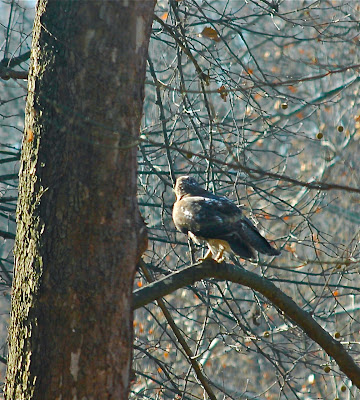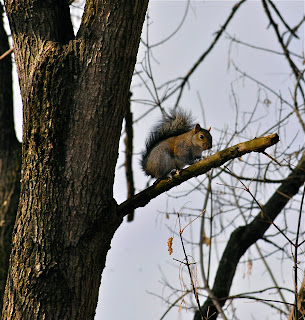The past few days have been rather perilous to the local gray squirrel population.
It began last week when I glanced out the window and saw a neighbor's cat proudly parading across the yard with a limp squirrel dangling from its jaws. Various cats are regular visitors here, attracted by birds coming to the feeders I have stationed about. For the most part, they're laughably unsuccessful. The birds keep a sharp lookout, plus there's not a lot of handy cover for concealment in the final critically-close range, and thus the long-distance rush-to-dinner usually ends with all birds making their escape well before the gonzo cats closes in. A bit of frustrated tail-swishing by the empty-clawed cat typically follows, which I find quite amusing.
 |
| Not the squirrel catcher…just catching a catnap in the wheelbarrow. |
Yes, now and then a cat does manage to pull it off. Not often, however; I'd say the ratio is maybe fifty rushes to one caught bird.
Squirrels seemed practically bulletproof—way too quick of reflexes, too speedy afoot, and too good at sudden direction changes. This is the very first time I've seen a cat catch a squirrel here at the cottage—and to be fair, I didn't actually witness the cat make the kill. For all I know, the squirrel could have met it's demise up on the road by bouncing off the bumper of a Buick.
Of course, the cat was just being a predator. Mouse, bird, squirrel…eats are eats. Everyone has to eat.
I hold the same attitude towards birds of prey. So when I looked out the same window a few days later and saw a redtail hawk land in the yard next to the river, maybe a dozen feet from the cottage door—a gray squirrel clutched in it talons, the only thing that upset me was that I'd left my camera in the pickup. I knew there wasn't a glimmer of hope that I'd be able to sneak out the back door and retrieve it, get back to the window, and make a photo without spooking the big hawk.
The redtail, a juvenile, sat on its kill for nearly fifteen minutes. At first it held its wings out, not fully extended, but sort of wrapped around its prey as if hiding it from view. Later it folded its wings back into place. I didn't see any struggles coming from the squirrel, so possibly the hawk was just being cautious. Every so often the hawk looked down, though it never tried to reposition its grip on the squirrel. But most of the time the bird kept a constant watch all around in every direction, head swiveling this way and that, scrutinizing everything.
 |
| A different redtail (I think) taken a few days later. |
About midways through this fifteen minute sit, a gray squirrel—one of several which had hunkered in the tree from which the hawk had snatched the hapless squirrel, and under which the bird now sat holding the unfortunate victim—came down the trunk, shaking it bushy tail and squacking loudly at the hawk. The irate squirrel approached to within four or five feet of the hawk. All the redtail could do was glare at the squirrel and take what I'm sure was a good cussing. I thought that was a pretty fearless act on the part of the gray squirrel.
Finally, the redtail flew off, the squirrel hanging like a fuzzy banner below its legs.
Incident three came this morning. Again, I witnessed it—the final milliseconds, anyway—through my deskside window. I was watching several squirrels chasing one another through the tops of the big sycamores along the river. Suddenly a blur caught my eye, which I realized was a falling squirrel. I didn't see the point from which the fall began, or know the reason it occurred…but I saw the final fifty-foot plunge, and heard the whap when the squirrel hit the ground—barely missing the upturned wheelbarrow—thirty feet from where I sat.
It isn't the first falling squirrel I've witnessed by a long shot. I've watched plenty of squirrels fall from power lines, treetops, off building, and bridges, and poles. Once I saw a squirrel attempt to jump from the top of a hundred-foot-tall cottonwood to a rocky cliff outcrop twenty feet away—only to miss completing the leap by several feet. What I've seldom seen, however, including the cottonwood-to-cliff attempt, was such a fall proving fatal. And this morning's plummet was no exception. After a minute or two of stunned immobility, the squirrel hopped over to the box elder near the front door, scampered up to a comfortable limb, and sat for awhile—considering, assessing, recovering? Whatever it is a squirrel does after such a plunge.
 |
| After the fall… |
Life for a squirrel can truly be…squirrelly.
———————
 Over by the board fence which marks the southern boundary of my streamside acre, the patriarch sycamore, a huge, towering specimen that is easily old enough to have been around when the Founding Fathers drew up the U.S. Constitution in 1787, loomed mysteriously, its topmost branches fading, spectral, almost vaporous, as if they were simply merging into and becoming one with the fog.
Over by the board fence which marks the southern boundary of my streamside acre, the patriarch sycamore, a huge, towering specimen that is easily old enough to have been around when the Founding Fathers drew up the U.S. Constitution in 1787, loomed mysteriously, its topmost branches fading, spectral, almost vaporous, as if they were simply merging into and becoming one with the fog.


 The poor jettisoned pumpkin made it as far as the riffle in front of the cottage, where it then got stuck in the shallows between the stones—doomed to mutely await the breakdown of the flesh that eventually comes to us all…or alternately, being set free by a providential rise in the water level, thus enabled to continue on its downstream adventure.
The poor jettisoned pumpkin made it as far as the riffle in front of the cottage, where it then got stuck in the shallows between the stones—doomed to mutely await the breakdown of the flesh that eventually comes to us all…or alternately, being set free by a providential rise in the water level, thus enabled to continue on its downstream adventure.